If you're looking for more ways to sell more online courses, look no further – Medium is the way to go. Medium is a platform that often gets overlooked by online entrepreneurs looking to market their businesses. However, it can ignite your top-of-the-funnel marketing.
The most common content marketing advice is to start a blog to market your business and attract new audiences. It's a good option, of course, but it's not the only one and might not work for some creators because setting up and running a blog can be time-consuming. And to be honest, it might be a bit more difficult to get any traction these days.
If you want to blog as a way to attract your target audience but don't want to deal with setting up, optimizing, and running a whole blog by yourself, Medium is a great alternative. It's an established platform with an existing audience, it's free to join for writers, and it can help content creators effectively establish themselves as thought leaders in their niche.
You might think that to grow an audience on Medium and reap the rewards, you need to be an established name like author Ryan Holiday or journalist Roxanne Gay. That couldn't be further from the truth. Medium has a targeted audience that is always looking for valuable advice on various topics from experts, no matter the size of your audience.
Before we talk about utilizing Medium to market your online course business, let's discuss the basics.
What is Medium?
Medium is an online publishing platform established in 2012 by Twitter's co-founder, Evan Williams. It's a hybrid between a traditional magazine and a blog with a twist. This makes Medium a truly unique platform. Another factor that makes Medium unique is the way it monetizes its platform – instead of using ads to make money, the platform charges a monthly member subscription fee.
"Like Vermont, Medium has no ads. That's because ads are a distraction from what you're here to do," explains Medium's CEO, Tony Stubblebine. As of April 2024, Medium has over one million paying members.
Medium doesn't keep all the money from memberships, though. Every writer who publishes on their platform and signs up for their Medium Partner Program gets paid for their writing. Not only can you, as a content creator, promote your courses, but also make extra money while doing so.
According to Medium, they have over 100 million active monthly readers who are actively looking for content to consume on the platform. That's a lot of potential customers.
Who uses Medium?
According to SmilarWeb, a third (27.77%) of Medium's audience is based in the United States. However, other English-speaking countries like the United Kingdom and Canada are in the top five countries.
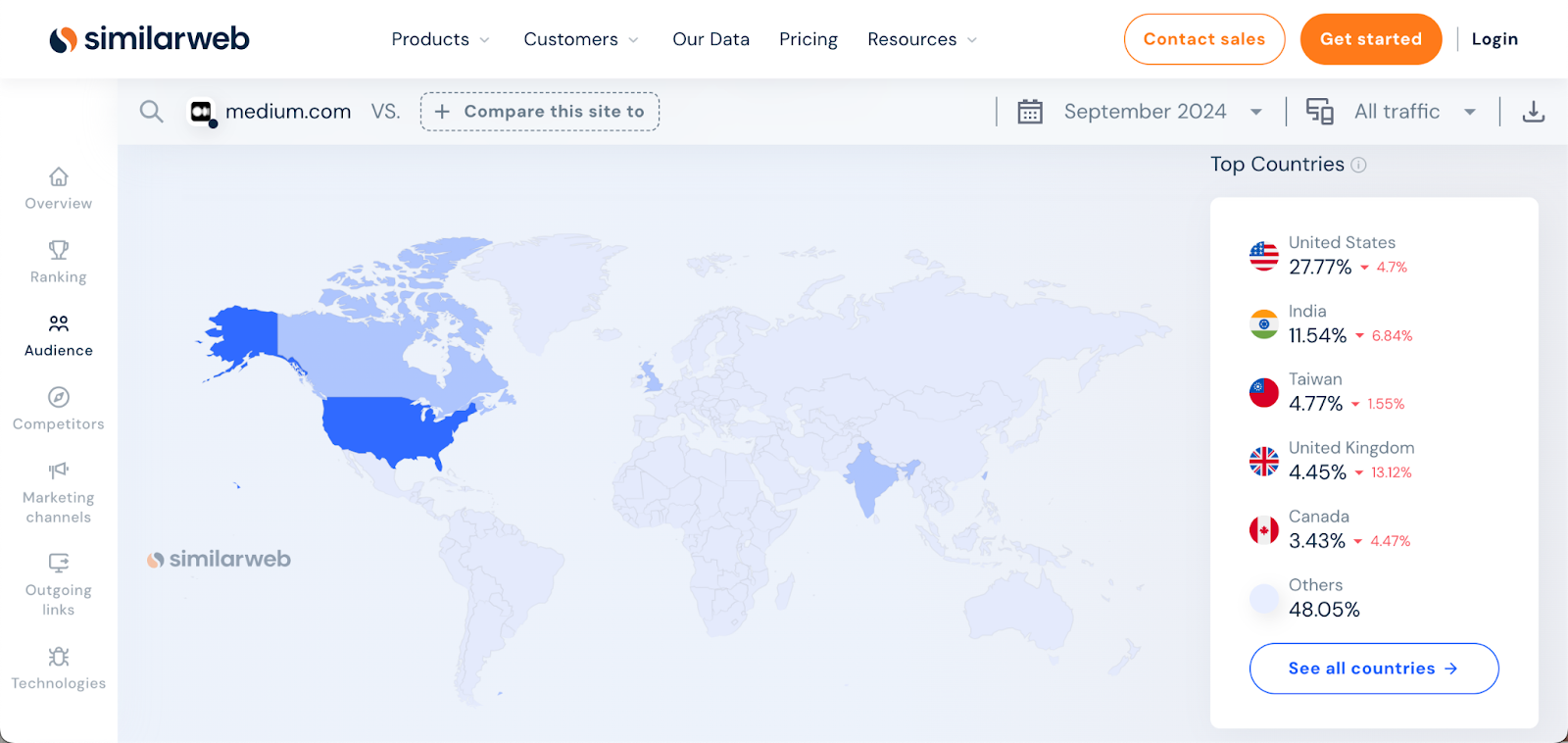
Interestingly, Medium's audience is male-dominated – 64.69% of members are male, and 35.51% are female. If you're targeting a male audience primarily, Medium might be the best platform to attract new leads. When it comes to age, Medium's audience skews younger – 36.38% of users are 25-34 years old, and 22.12% are 18-24 years old.
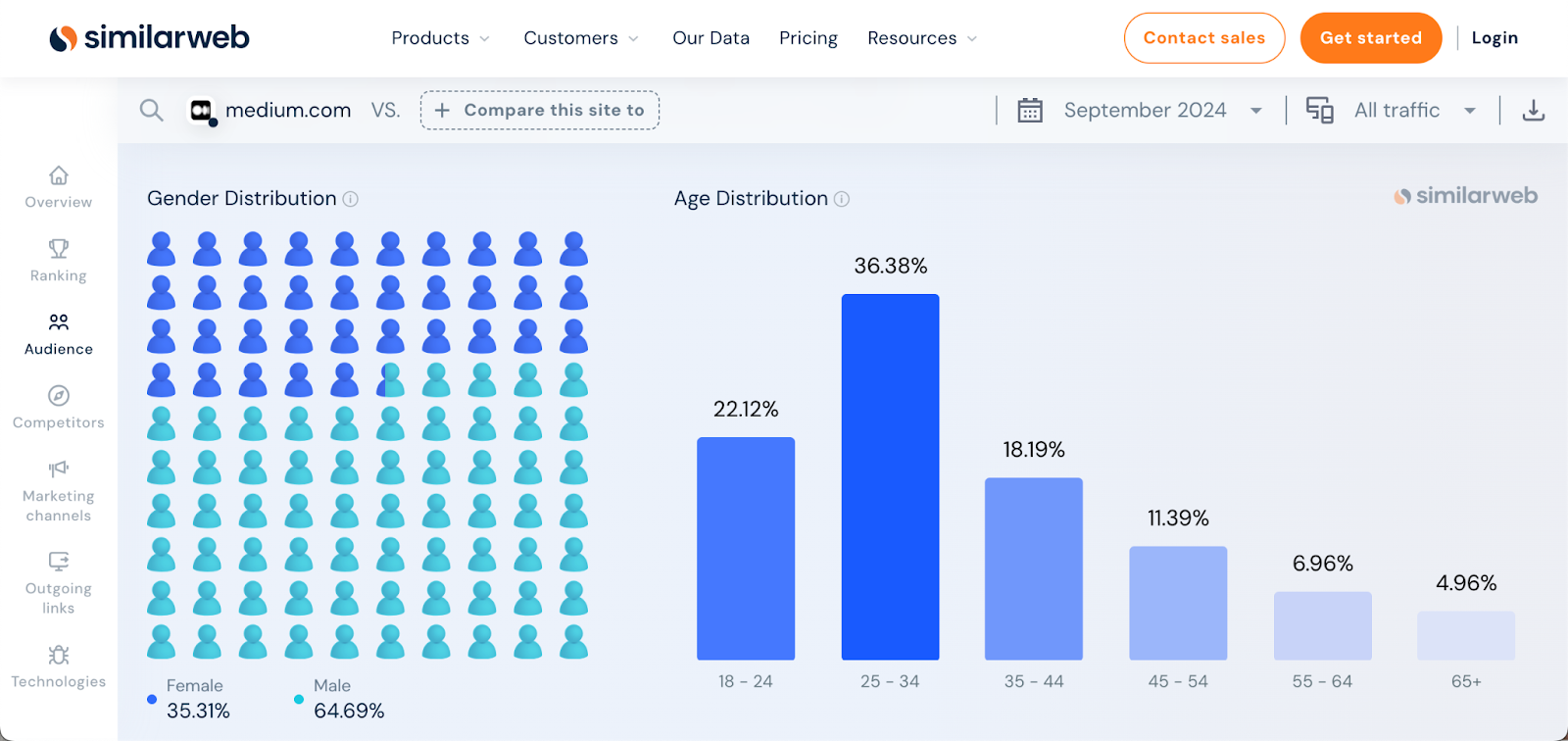
In terms of Medium's audience's interests, the top three categories are:
- Programming and developing software.
- Computers, electronics, and other technology.
- Graphics, multimedia, and web design.
When it comes to what topics interest people, news, business, and software are the top three most popular on the platform.
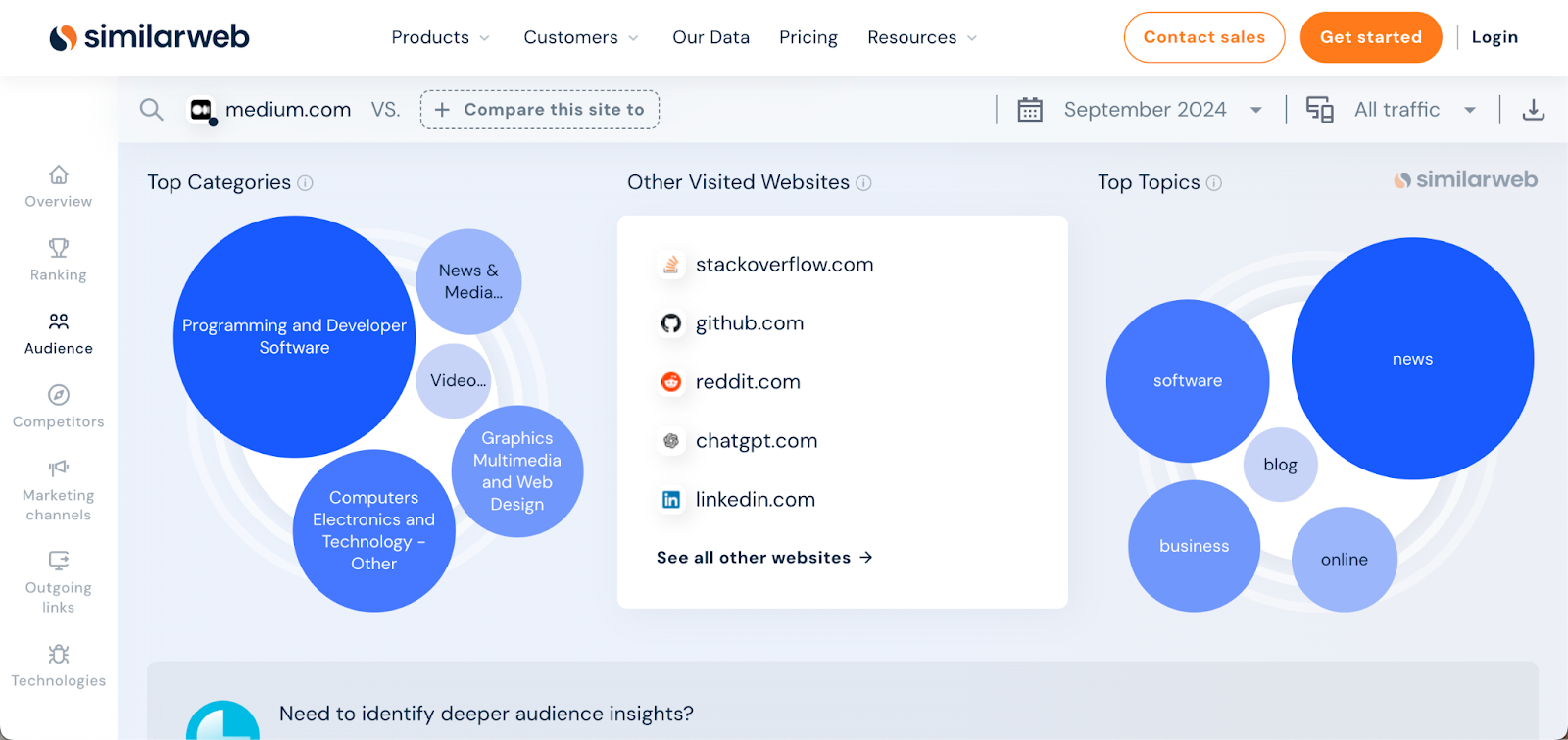
Medium Partners Program
Medium Partner Program (MPP) is a program that allows writers who publish on the platform to make money from their articles. You don't have to be famous or have a large audience to sign up for it. All you need is to meet the three eligibility criteria:
- Be a Medium Member.
- Have one story published in the last six months.
- Live in one of the eligible countries.
Once you register for the Medium Partner Program, you'll be able to mark which story is behind the paywall and is eligible to earn money:

Articles that are behind the paywall and can earn you money will be marked with a star in your dashboard so you can easily track them:

While your main goal with Medium is to grow your personal brand, reach new audiences, and market your online course business, it's still useful to take advantage of the program and add one more stream of income for your business.
Medium vs. blog—which one should you choose?
Common expert advice online is to have a blog because it belongs to you. You won't have to worry about pleasing the algorithms, which are often out of your control and change rapidly. While that's valid advice, blogging can be expensive and time-consuming for online course creators like you, who already wear so many hats. But let's compare the two options a little more in-depth.
So, what are the pros and cons of publishing on Medium?
Pros
- No upfront costs to publish
- Access to over 100 million monthly readers looking for content to consume
- You can establish yourself as an expert and thought leader in your niche
- Collaboration opportunities and community
- The only thing you need to worry about is writing great content – marketing is taken care of for you
- More chances of your content ranking highly on Google because of Medium's high authority
- An opportunity to make money if you sign up for MPP
Cons
- Not many customization and personalization options
- You're dependent on the platform's internal changes, which are out of your control
Now, what are the pros and cons of starting your own blog?
Pros of starting your own blog
- You own the blog and don't have to deal with platform changes or algorithms
- Full creative control over design and web building
- Infinite potential to scale and change the blog as your business grows
- Easier to set up a sales funnel and sell your products directly on your website
Cons
- Upfront costs can be a lot for some creators
- You need at least basic technical knowledge of how to set up and run a website
- You need to learn how to optimize for SEO
- The marketing is fully your responsibility
- Admin might take up a lot of time
Both a blog and a Medium are good options. Which one you'll choose will depend on what your business needs are. Medium might be a great option for new entrepreneurs who want to dip their toes in content marketing and blogging to promote their business and build a personal brand. If you have resources, you might consider starting a blog instead.
How to set up your Medium account
Let's go over how to quickly set up your Medium account for success. Anyone can join, so you can start writing right away.
Sign up for Medium
Creating a Medium account is very easy. You can sign up with either your Google or Facebook accounts or with an email:
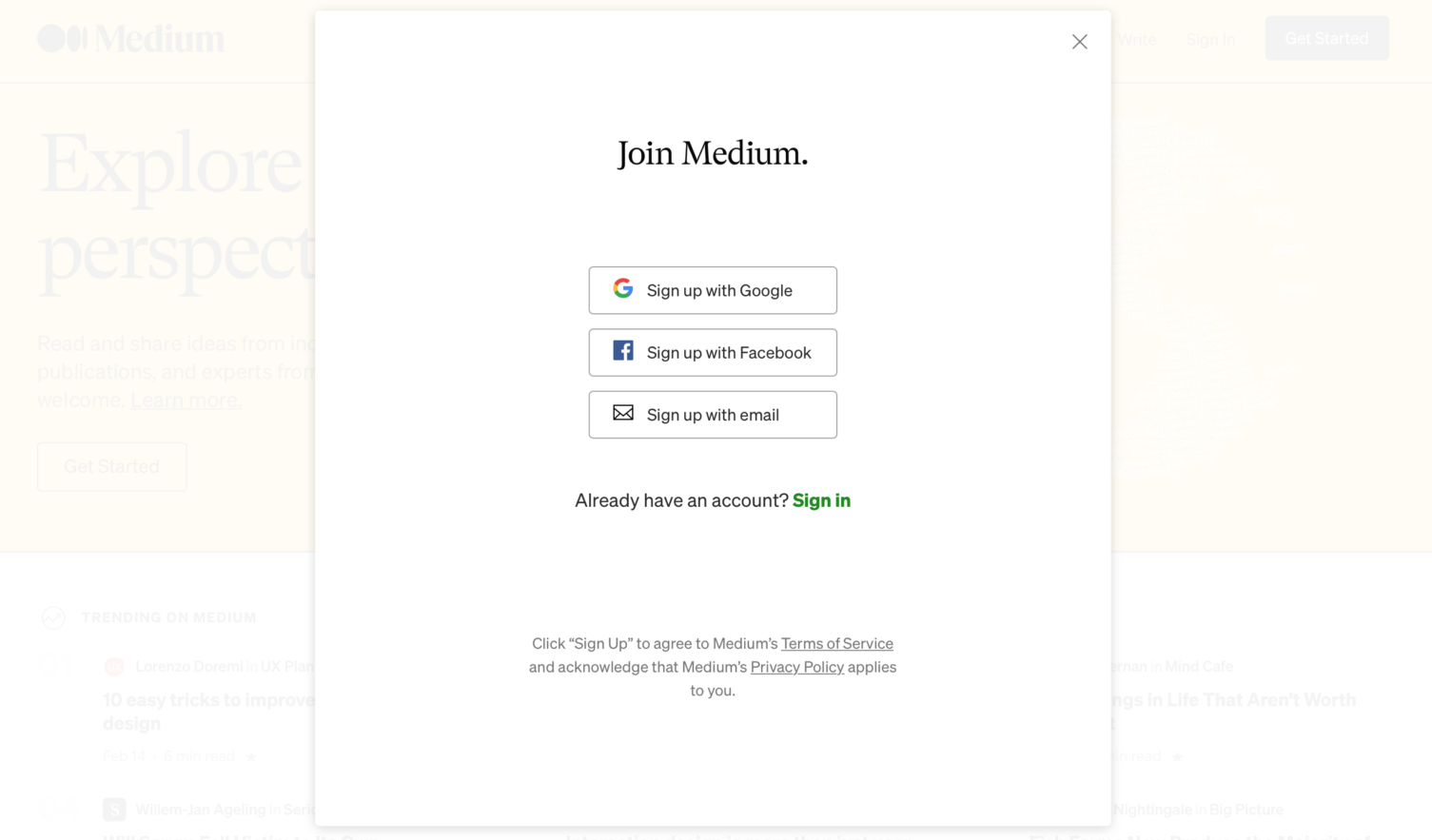
Once you type in your email, Medium will send you an email with a link to finish setting up your account:

Set up your Medium profile the right way
The next step is to set up your Medium profile. If you click the icon at the top corner of the screen on the main page, a dropdown menu will open. Go to Settings:
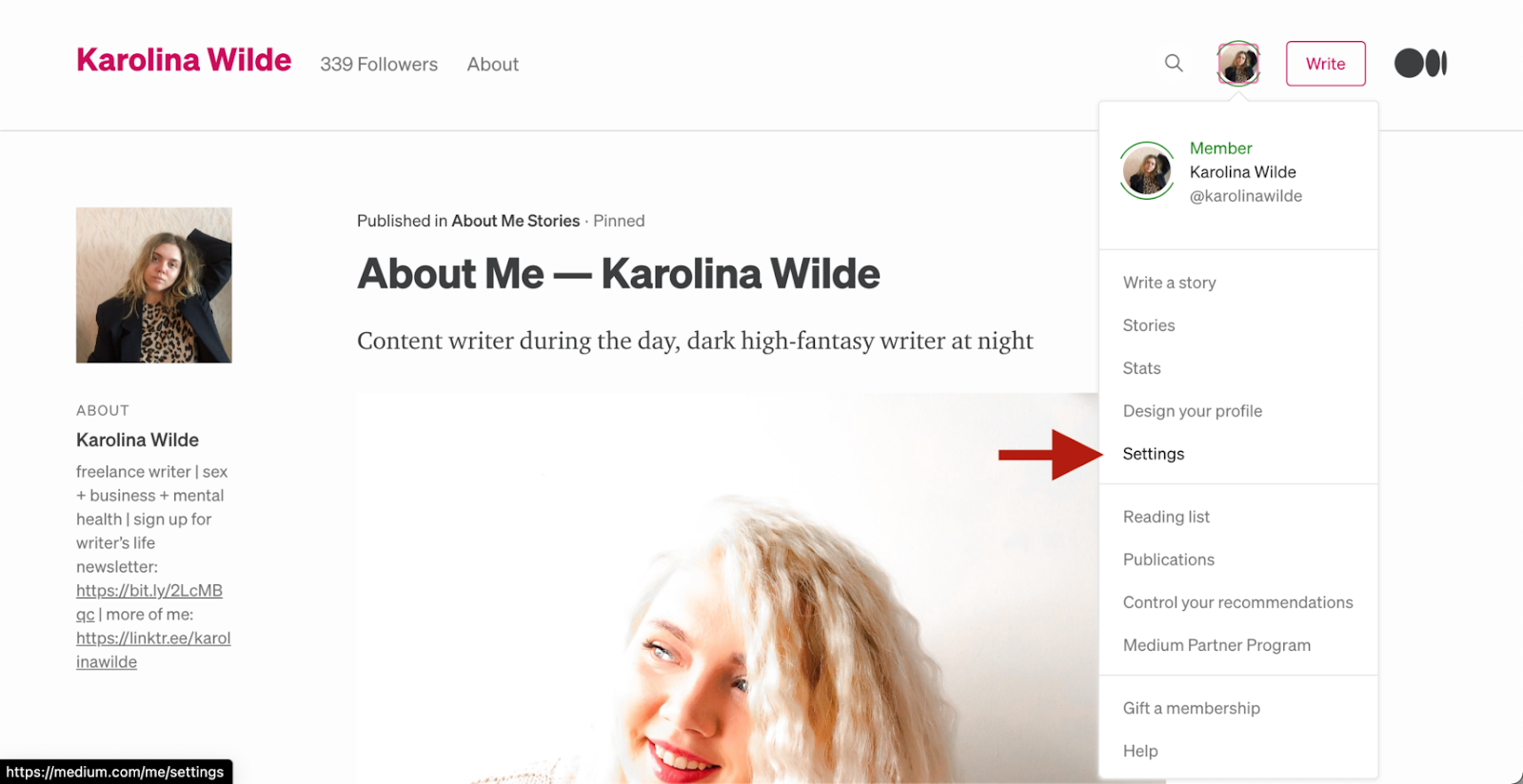
Here, you can control all the settings on your account and how your profile appears when someone visits your page. You can add your profile picture and customize your username and URL. We recommend keeping it on-brand with your business and is easily searchable:

Medium allows writers to customize the design of their profiles. This is great news because it allows you to showcase your personal brand on the platform to make it easier to recognize and match the rest of your business. You can change fonts and colors, add images to your page, and get as creative as you want.
Optimize your Bio section
Your Bio or About section is the most important part of your Medium profile. Here, you have the opportunity to introduce yourself and your brand. Be sure to include relevant links you want people to visit when they stumble upon your account:
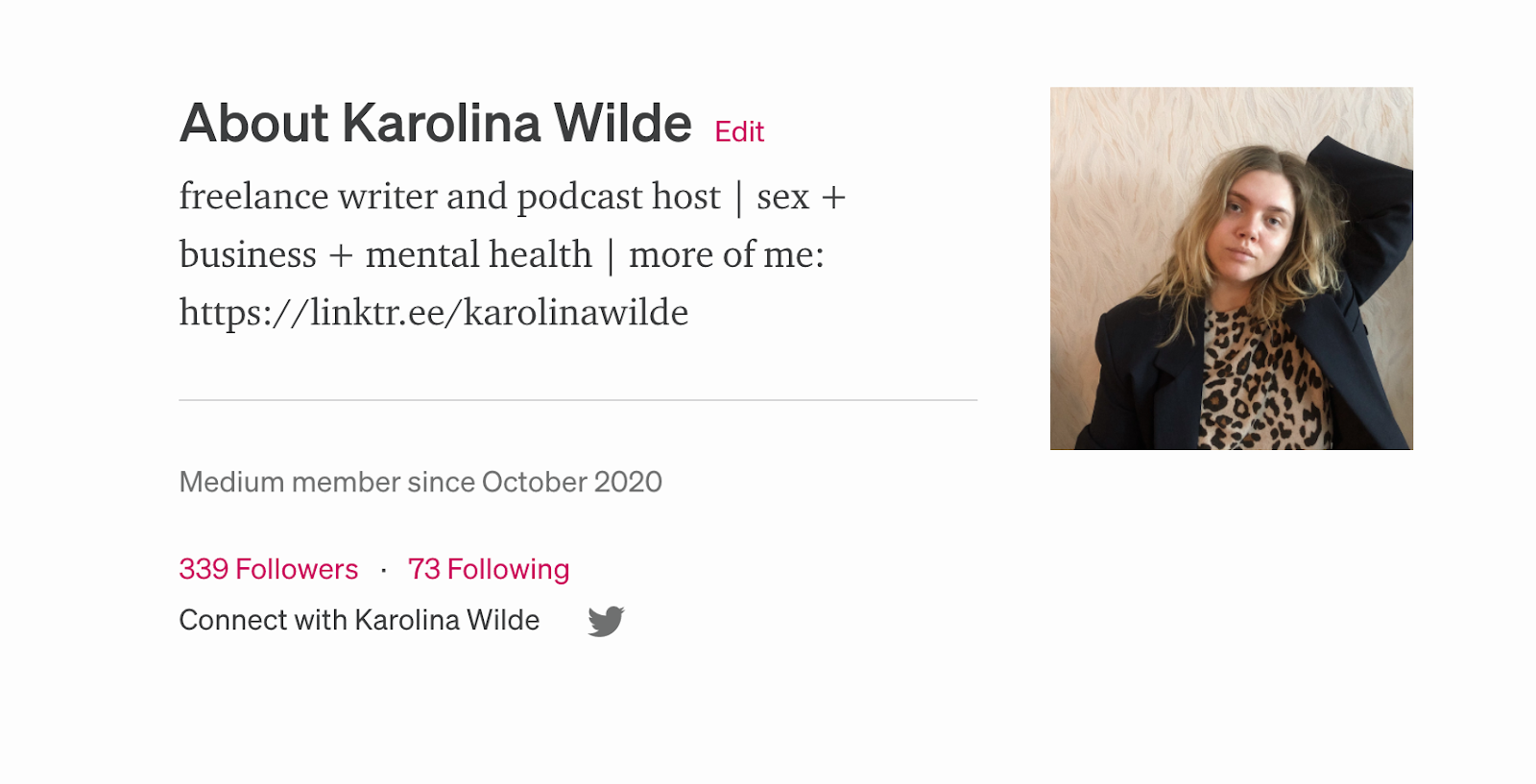
It's good to include who you are, what topics you write about, or what your business is about. This is also a place where you would include any important achievements you want people to know about you.
Pro-tip: In your Bio, you want to include a CTA inviting people to visit your website or sign up for your email list. If you are publishing with publications on Medium, they often don't allow CTAs in the actual article (more on that in a moment).
How to market your business on Medium: your step-by-step Medium sales funnel
Once your Medium account is set up and optimized, it's time to start working on your sales funnel strategy. Here is a step-by-step roadmap for marketing your online course business on Medium:
Step 1: Pick three topics around your niche
Just as with creating an online course, having a niche on Medium is crucial for growth. Just remember, on Medium, try not to get too niche. If you do, it may be hard to create content, or you may run out of ideas and topics to write about.
Most writers on Medium choose three topics that complement each other to write about. For example, if you're a lifestyle coach who sells online courses on how to create a better life, you could write about personal development, relationships, and mental health.
These three topics give you enough space and wiggle room, and they all resonate with your ideal audience, who would be interested in the online courses you have to offer.
Step 2: Make a list of publications that fit your niche the best
The key to rapid growth on Medium and successful marketing of your business is getting your writing into the biggest publications on Medium. This ensures that your ideas and articles are reaching a broader audience. Plus, being featured in these publications will allow you to establish your personal brand.
You want to focus on big publications with over 100k+ readers, but you shouldn't ignore smaller publications with more niche audiences. Sometimes, getting your article in front of a smaller but more focused group can bring better results than talking to a broader audience.
The best practice is to have a healthy mix of big and small Medium publications that your ideal audience would be interested in reading. Each publication you visit has a page with its submission guidelines, and you should pay attention each time before submitting to a new publication.
"Each publication is a curator of a level of quality and a point of view," says Stubblebine. Some publications might be harder to get into than others. It might take you some time to get into the grove, so be patient.
Medium has an extensive list of active publications on their platform that are accepting new writers. However, here are four prestigious publications you want to target if they fit your niche:
- Business and Entrepreneurship: The Start It Up, 700K+ subscribers
- Data Science: Towards Data Science, 690K+ subscribers
- Graphic Design and UX: UX Collective, 460K+ subscribers
- Personal development and storytelling: Human Parts, 300K+ subscribers
Step 3: Write an engaging post and submit it to publications
If you already have an established blog and want to repurpose your old content, you can re-post blog posts from your blog on Medium. However, before submitting repurposed posts to publications, check whether they accept them. Some pubs do, some don't.
Thankfully, writing a new post on Medium is easy. Click on the little icon at the top corner of your screen, and click Write a story on the dropdown menu:

Medium has various formatting tools, so you'll have a lot to work with, and you can use all those tools to make your articles stand out in the crowd.
Also, Medium has its own guidelines for writing the best content, so check them out and read them carefully before publishing. Quality content is key to success on Medium, so invest the time in crafting the best content you can before publishing.
Writing on Medium is only effective for your business if you get your writing in front of a new audience, and for that, your writing needs to be of good quality and provide value to the audience.
Medium rewards quality content – Medium has a content distribution system to push the content that's published on their platform in front of the right audience. There are three different distribution systems:
- Network distribution: when your article is pushed in front of people who follow you or the publication in which your article was published.
- General distribution: when your article is pushed in front of people based on their interests, other writers, and publications they follow.
- Boost: prioritized articles that are pushed in front of people based on their interests (this is what you want to be aiming for!).
Step 4: Direct people to your email list
While most Medium publications won't allow CTA's in the actual body of content, you should include a link to your email list in your bio that will direct readers to your email list.
Anytime someone is reading your article, they'll have your bio on the side of the screen with all of your links clickable:
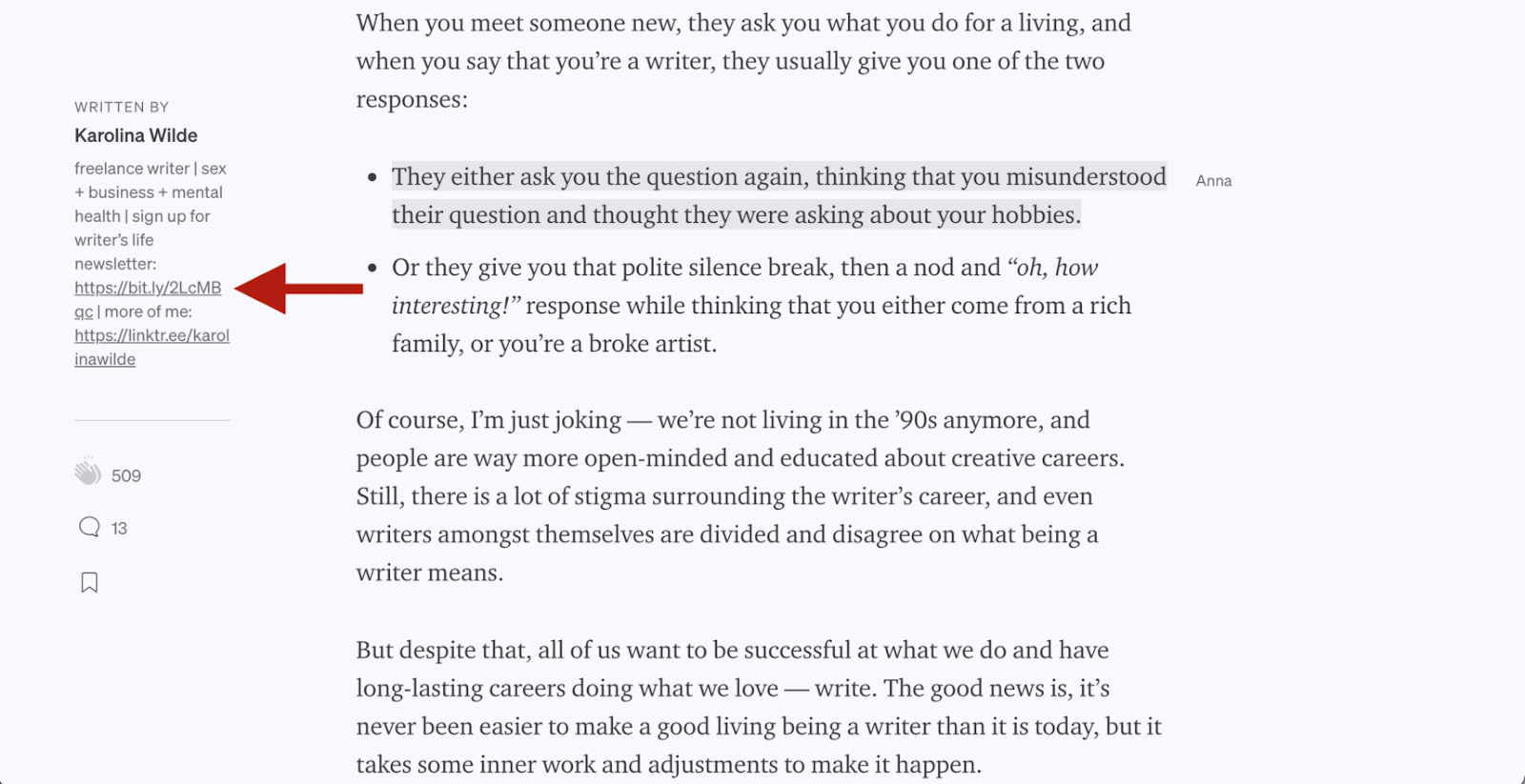
Include your CTA and a link directing readers to sign up for your email list, where you'll be further nurturing the relationship with your audience before pitching a sale.
Step 5: Nurture new leads
Now, it's time to nurture all those new leads you collected through Medium and turn them into paying customers. So, set up an automated email welcome sequence for all the new email subscribers who come from Medium. Introduce them to who you are and what they can expect from you before you promote your digital products and online courses.
It's essential to dedicate time to build a stronger and more intimate relationship with your list that will convert into online course sales for your business.
Step 6: Convert those leads to sales for your course
Check out Teachable's guide and template for the perfect sales page.
{{salespage-component="/blog-shortcodes/blog-popup"}}
Join more than 150,000 creators who use Teachable to make a real impact and earn a real income.


